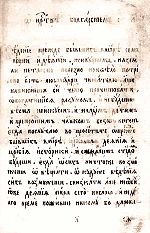
Istoriya Slavyanobolgarskaya
Encyclopedia

Bulgarian language
Bulgarian is an Indo-European language, a member of the Slavic linguistic group.Bulgarian, along with the closely related Macedonian language, demonstrates several linguistic characteristics that set it apart from all other Slavic languages such as the elimination of case declension, the...
: История славянобългарска, Istoriya slavyanobalgarska, and translated as Slavonic-Bulgarian History) is a book by Bulgaria
Bulgaria
Bulgaria , officially the Republic of Bulgaria , is a parliamentary democracy within a unitary constitutional republic in Southeast Europe. The country borders Romania to the north, Serbia and Macedonia to the west, Greece and Turkey to the south, as well as the Black Sea to the east...
n scholar and clergyman Saint Paisius of Hilendar. Written in 1762, it is considered Saint Paisius of Hilendar's greatest work and one of the most influential pieces of the Bulgarian revival, as well as the first work of Bulgarian historiography
Historiography
Historiography refers either to the study of the history and methodology of history as a discipline, or to a body of historical work on a specialized topic...
. Paisius' motivation to write this piece of literature was to ensure that a "nation with a glorious past has the right to a splendid future".
Although he was based in the Hilendar Monastery in the Holy Mount Athos
Mount Athos
Mount Athos is a mountain and peninsula in Macedonia, Greece. A World Heritage Site, it is home to 20 Eastern Orthodox monasteries and forms a self-governed monastic state within the sovereignty of the Hellenic Republic. Spiritually, Mount Athos comes under the direct jurisdiction of the...
(today an autonomous province in Greece
Greece
Greece , officially the Hellenic Republic , and historically Hellas or the Republic of Greece in English, is a country in southeastern Europe....
), Paisius travelled extensively throughout the country and abroad and collected a vast amount of references to compile and write his concise but extremely powerful version of Bulgarian history.
The importance of this manuscript is that it was able to restore national pride to a country, which after 366 years of Ottoman rule was lacking in such passion. What would follow is known as the Bulgarian National Revival
Bulgarian National Revival
The Bulgarian National Revival , sometimes called the Bulgarian Renaissance, was a period of socio-economic development and national integration among Bulgarian people under Ottoman rule...
, in which Istoriya Slavyanobolgarskaya played a significant role.
The book's first manual copy was done by Sophronius of Vratsa
Sophronius of Vratsa
Saint Sophronius of Vratsa , born Stoyko Vladislavov , was a Bulgarian cleric and one of the leading figures of the early Bulgarian National Revival....
in 1765. Structurally, Istoriya Slavyanobolgarskaya consists of two introductions, several chapters that discuss various historic events, a chapter about the "Slavic teachers", the disciples of Cyril and Methodius, a chapter about the Bulgarian saints, and an epilogue.
The Zografou
Zograf Monastery
The Saint George the Zograf Monastery or Zograf Monastery is a Bulgarian Orthodox monastery on Mount Athos in Greece...
draft of the Istoriya Slavyanobolgarskaya is depicted on the reverse
Obverse and reverse
Obverse and its opposite, reverse, refer to the two flat faces of coins and some other two-sided objects, including paper money, flags , seals, medals, drawings, old master prints and other works of art, and printed fabrics. In this usage, obverse means the front face of the object and reverse...
of the Bulgarian 2 levs
Bulgarian lev
The lev is the currency of Bulgaria. It is divided in 100 stotinki . In archaic Bulgarian the word "lev" meant "lion".It is speculated that Bulgaria, as a member of the European Union will adopt the Euro in 2015 .- First lev, 1881–1952 :...
banknote, issued in 1999 and 2005.
External links
- Full original text of "История славянобългарска" including commentary, bibliography, and a biographical note about the author by Yordan Ivanov, published in 1914 by the Bulgarian Academy of Sciences (in Bulgarian)
- Excerpts from Istoriya Slavyanobolgarskaya in modern Bulgarian
- L’Histoire slavo-bulgare de Paisij de Hilendar Traduction et commentaire French translation and commentary by Athanase Popov (retrieved on 24 July 2009).

